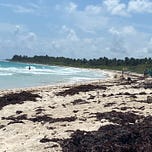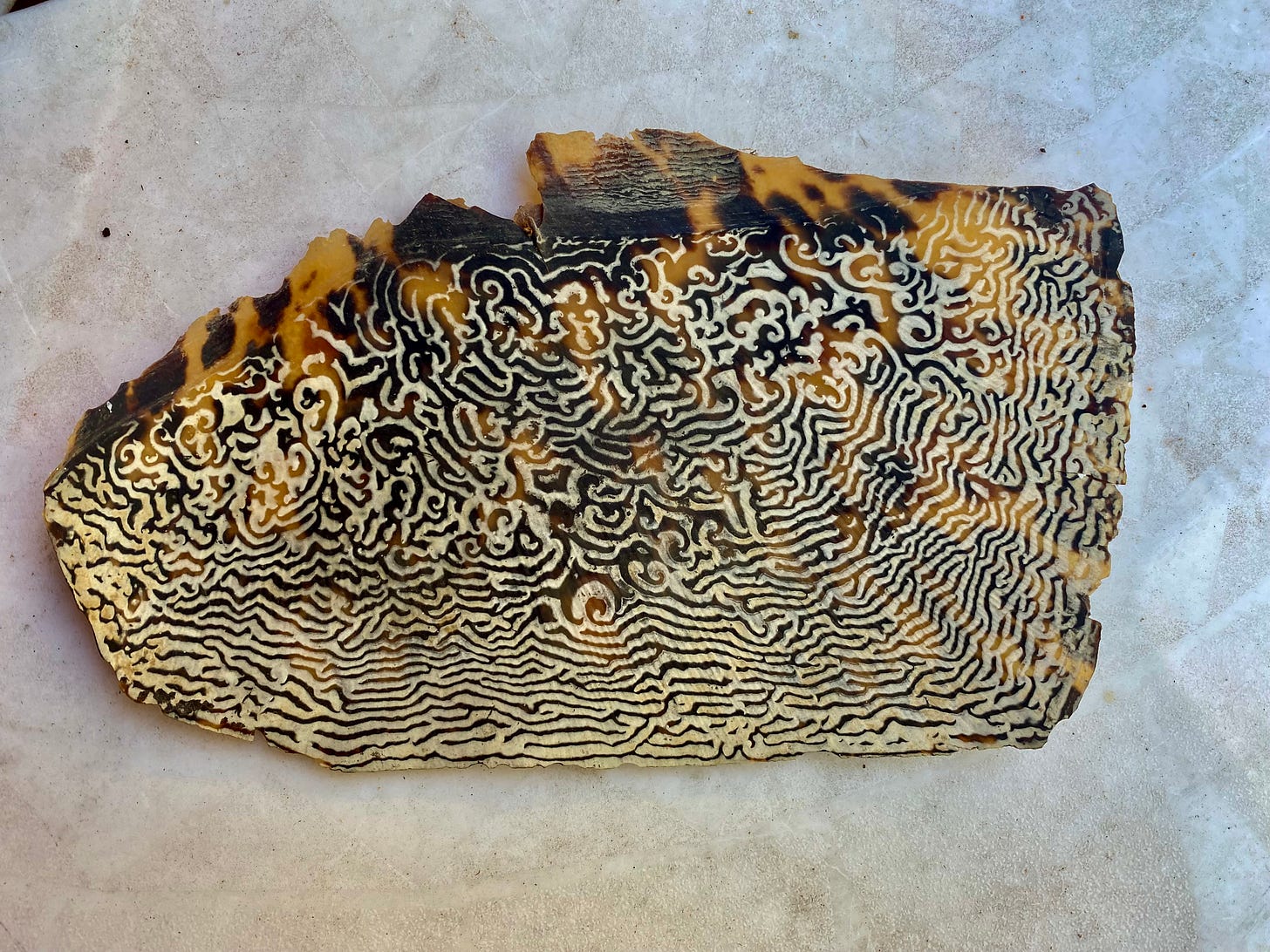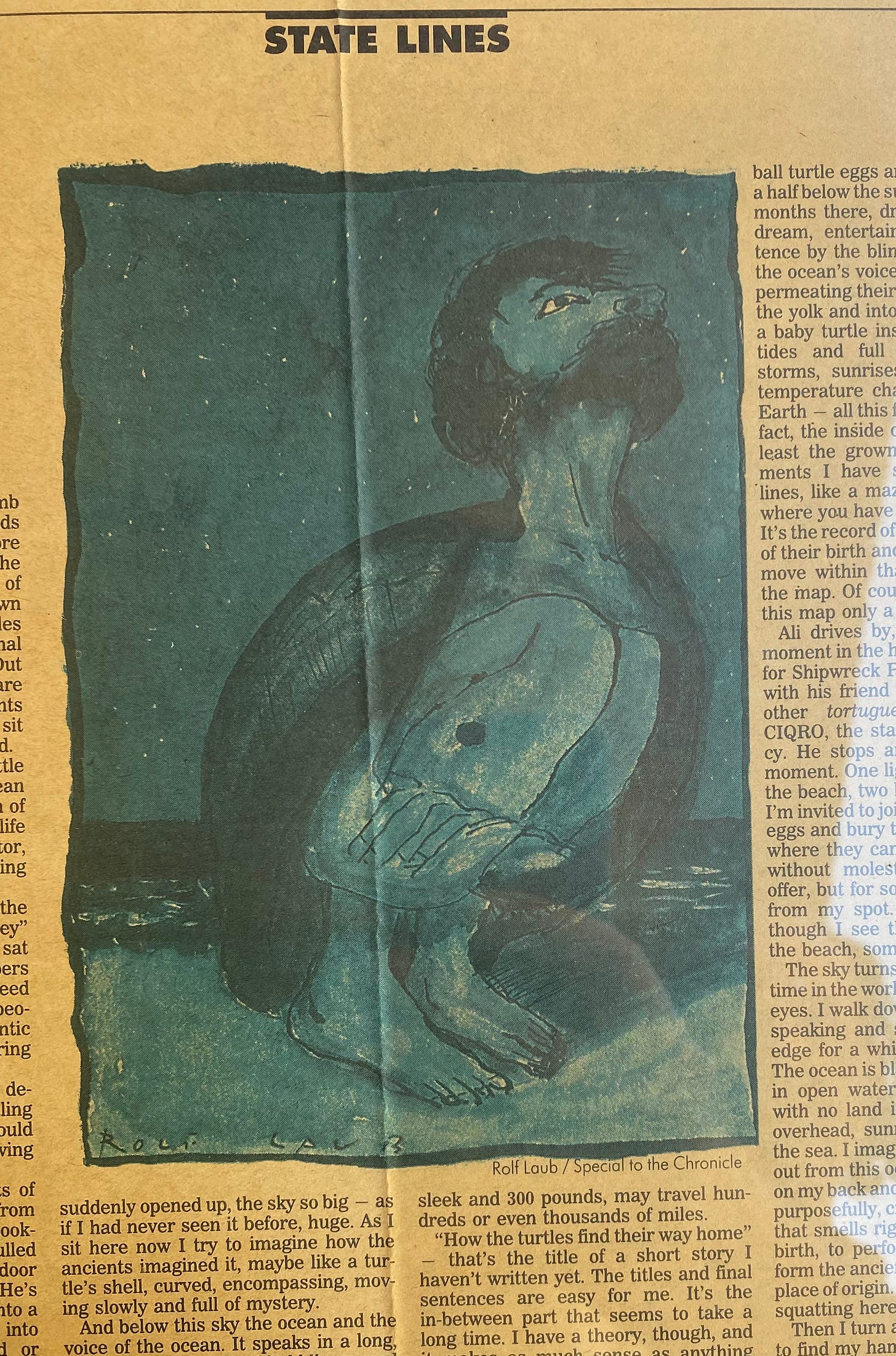Once upon a time, back in the nineties, when Tulum was just a sleepy little Mayan village and the Caribbean coast still had sandy beaches with palm trees and mangrove swamps and wild jungle stretching out endlessly, I lived in Mexico.
I lived on one of those sandy beaches with palm trees. Infact it even had a cenote back off in the mangroves aways. Cenotes are fresh water pools that the Yucatan is famous for. They proliferate there because of all the rainfall that falls on that flat limestone rock covered with tropical jungle (which is the Yucatan peninsula). It travels underground like a river and carves out caves and caverns and tunnels on its way to the sea. Sometimes the tunnels collapse and form the cenotes, aka the eye of the jungle, the jewel of the jungle. Known to the Mayans for thousands of years and now known to the tourists who come to jump in and witness the amazing underwater tapestry: the regal curtains, the columns, the flowstone and icicle needles of the speleothems. It’s highly decorated inside most cenotes.
Anyways, Xcacel Beach (Ish ka sell) is one of those sandy beaches. I had a bunch of adventures living there. From our little dive shop on the beach, we used to take tourists scuba diving on the reef and back into the jungle to swim in the cenotes.
A Mayan family owned the Dos Ojos cenote a mile or two back in the jungle, thanks to the revolution of 1910 that redistributed the land (or more accurately distributed it for the first time since it had never been distributed at least since the Europeans showed up and conquered everything. Back then only rich people owned land). Anyways, we would take a truck load of tourists back to where Maria de la Selva lived with her husband and kids. For them it was their source of water, what they used for everything from bathing to cooking. For us it was a thrilling underwater adventure.
‘Dos Ojos’ means ‘two eyes’ and so it was that the two pools lay next to each other and you could see the light of one eye from the other eye when you went underwater with a mask on. Diving mask, not halloween mask. It was possible to swim from one eye to the other eye underwater by stopping at an air bubble along the way to get a fresh breath. We called it ‘the Dive of Doom’. We discontinued it when the air bubble in the middle started to become stale but the tourists (young adventure vacationers) loved it.
I have lots of stories about living there and diving and all kinds of stuff but the story I want to tell you is about Maria de la Selva. That’s what I called her anyways, it wasn’t her real name. She would watch, bemusedly, each time I brought a group of white skinned tourists down the rocky path and past her house and jumped into her cenote with dive gear on - sometimes snorkel gear. She seemed to notice everything, including my beat up old four-wheel drive Scout that I used to drive back and forth and parked nearby. I used to joke with her as we went down to jump in her cenote. I think that’s where I came up with the name. She seemed to enjoy my broken Spanish and my canted sense of humor and we became friends.
One day she asked me if I would teach her how to drive my Scout. Hmm. Why not? I asked myself, There’s no traffic on this road it’s just bumpy. It would be fun. So I did. We climbed into my Scout, Maria de la Selva in the driver’s seat and I showed her how to use the clutch and get it into first gear. The road was basically a path made by hacking through the jungle and smoothing out the rocks, atleast sort of smooth. By the time she got it into second gear that was about as fast as you could go. I, for some reason, apologized for the bumpy road (it was her road not mine) and she said no, she liked the bumps.
She successfully drove up and down that road and we ended up back at her palapa by the cenote where her life as a Mayan wife and mother was waiting for her. She had a pretty traditional lifestyle: they grew corn and other crops in their milpa, slept in a hammock in a thatched roof palapa, had a donkey for transportation. I thought that was the end of it.
One day while I was at the cenote helping some divers gear up and get in the water she came down and watched us. Later, after we had finished the dive and were on our way out, she was still there. She asked me, Would you teach me diving? Oh my god. That would mean training and equipment and breathing underwater and what about the husband. I said, no. It wasn’t possible. Too complicated. No way Jose or in this case Maria.
I wasn’t about to get involved in a marital dispute with a family that we were doing business with. I thought about it though. A couple of days later I realized, Hey wait a minute, I am a diving instructor, that’s what I do. Why can’t I teach Maria diving? The reason, of course, was the husband. I didn’t know him well but he didn’t seem like he had the same kind of bridge burning spirit of adventure that his wife did. He seemed comfortably established in the fabric of his Mayan micro-society and I didn’t want to rile it up.
Eventually I came to the startling conclusion, that yes, I could indeed take Maria de la Selva diving but I would have to take her husband too. Oh boy. So, one fine day I arrived in my Scout with diving gear, mask, fins, weight belt, everything, air tanks, and we proceeded to gear up and get in the water and do the training in the shallow water. That was the first problem, there wasn’t any shallow water, it just went straight down. We had to pump up our BCDs (buoyancy control devices) and float while we learned how to clear our mask, clear the regulator, take it out of our mouth, put it back in, how to descend and ascend safely and to never, ever stop breathing. When I felt like we had covered everything pretty good I gave the signal to descend and we went underwater. Maria de la Selva did fine, of course, as she swam around inside her cenote, seeing it in a way that she had never seen it before. Her husband, I don’t remember his name, was tense as a cat in zero gravity (if you can imagine that), in the ISS space station or something, so I just held on to his BCD strap the whole time. I never let him go, just watched his face to make sure he was ok.
I took alot of people diving while living on that beach, mostly in the ocean. One time we came up from the 30 foot reef, surfaced next to the boat, pumped up our BCDs and pulled off our masks. It had been the first time for all of them. I remember looking at their faces, flushed with wonder and astonishment, cleansed from having been in the primordial sea, with the surge and the sea fans and the fish and all of us swaying gently together. In that moment, for some reason, I remembered my father. He had wanted me to become a Baptist minister like him but I strayed far and wide in search of my own truth and here was a great truth. Here was a baptism. They’re thoroughly baptized, I thought to myself floating there in the water next to them, I kinda became a Baptist minister after all.
Xcacel was (is) a turtle beach, one of the most important nesting sites in the whole Caribbean basin because of the number and variety of sea turtles that come ashore there. From June to August the sea turtles crawl out of the heaving ocean, drag themselves up the beach, dig a hole and lay their eggs. A hundred little ping pong ball sized eggs with the fertilized embryo of a baby turtle inside. Sometimes I would help the tortugueros out on the beach, spotting the mama turtles coming ashore and checking their tag. They had a stainless steel tag on their flipper or we would give them one.
Sometimes I would help with the turtle tanks my friend and business partner Buddy built. The idea was to hold some of the newly hatched baby turtles in salt water tanks and feed them so they could get bigger. This would improve their chances of surviving the dangerous reef crossing where the barracudas and the sea hawks and the pelicans were all waiting for them. The waters of the shoreline and the deep blue sea, which they dearly loved with all their little turtle hearts, also held the predators that ate them.
When baby turtles are born, or hatched to be more accurate, in the middle of the night they come bubbling up out of the sand like coffee in a percolator and head straight for the water. No matter how rough the surf is they plunge in. Sometimes they get thrown back several times but they keep trying until they can get out beyond the surf line. They have a one in a hundred chance of living to maturity but mortality is not their concern, their original and primordial impulse to be in the ocean is.
I witnessed this every year on Xcacel beach, late in the summer. Those same turtles that hatched there had swum out for hundreds or maybe thousands of miles into the open ocean and returned to the same beach that they started from when they were ready to lay their eggs. This is what they have determined. Amazing. How do they do that?
I finally left Xcacel beach in 1995 and returned to my traditional lifestyle in the States, became a businessman again and drove around on the streets and highways of my native land but I never stopped wondering - how do they do it, find their home beach again after swimming around all over the Caribbean sea? I think I had turtles on my brain.
One day, back when I was still living on Xcacel Beach, I came across a piece of turtle shell. It had been torn off the carapace of a large sea turtle somehow and you could see the outside pattern and the inside pattern. The Chinese used turtle shells for augeries, the Native Americans believe that the world was created on the back of giant sea turtle floating in the primordial ocean. What’s all that about? I saved that piece of turtle shell, still have it. It seemed to offer clues to a great mystery of some sort, if only I could figure out what it was.
A couple of years passed back in good old civilization and I started to feel the urgent need to go back to turtle beach, to Xcacel, to revisit the place that had had such an impact on me at a formative time in my life. The Ford van that I traveled in and did my business with was self-contained, sort of. It kind of looked like a turtle with it’s hard brown case and blunt nose. So I geared up and drove out along the long curve of the Gulf of Mexico from San Antonio to the Yucatan.
The day I arrived back at Xcacel in my turtle van, I parked near a couple of palm trees where I could sling my hammock, said hi to some old friends and walked up to the top of the berm. The sun was setting and the tortugueros were just starting to walk the beach, setting up their watch stations. Ali drove by and invited me to join him. He was headed for Shipwreck Point with his friend Leo, his niece and two other tortugueros but for some reason I couldn’t move from that spot. Thunderstorms were brewing in the north, more lightening in the east. The tortugueros flashlights flickered on and off whenever they sighted a turtle coming out of the surf. A few stars appeared overhead. Marine bioluminescence sparkled on the beach.
I walked down there, crouched in the sand and looked out at the sea, listened to the voice of the sea and thought about sea turtles navigating in the open ocean. How do turtles find their way home? Here’s my theory.
The turtle maps are drawn under the sand when the little ping pong ball turtle eggs are gestating a foot and a half below the surface. They spend two months down there, dreaming their creation dream, entertained in their pre-existence by the blinking stars, sung to by the ocean’s voice, the smell of the sand permeating their leathery shell and into the baby turtle inside. Sea currents and tides and full moons and summer storms, sunrises and sunsets, subtle temperature changes and the turning Earth - all this forms an impression. In fact, the inside of a sea turtles’ shell, atleast the grown-up, shark-bitten fragment I’ve seen, are etched with lines, like a maze, like a child’s puzzle where you have to find your way home. It’s the record of their growing, the story of their birth and their travels, and how they move within that etching. They carry the map on their back.
Sitting on the beach of Xcacel that night, staring out at the dark ocean, I imagined swimming in open water hundreds of feet deep with no land in sight, the sky turning overhead, sunrise, sunset, sleeping in the sea. I imagined being a turtle looking out from that ocean and feeling the map on my back and swimming to this beach, purposefully, crawling out onto the sand that smells right, onto the beach of my birth to perform the renewal, to perform the ancient ritual of creation in my place of origin. I imagined all those things squatting there on the beach. Maybe that’s how they find their way home.
Then I turned and walked up the berm to find my van and hang my hammock and find my rest and feel my map.
music at 10:58
















Share this post